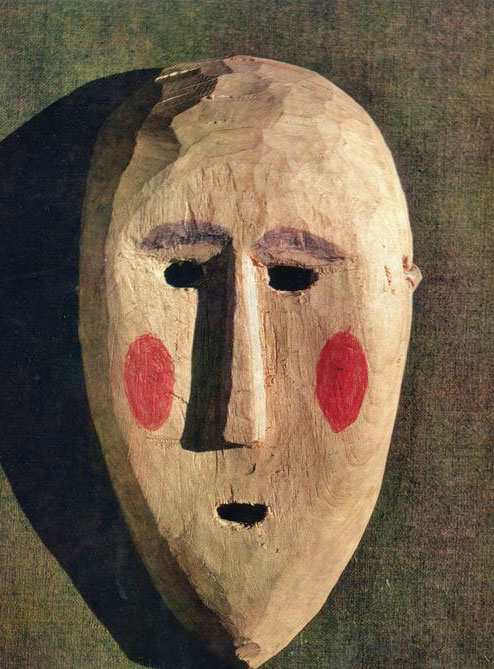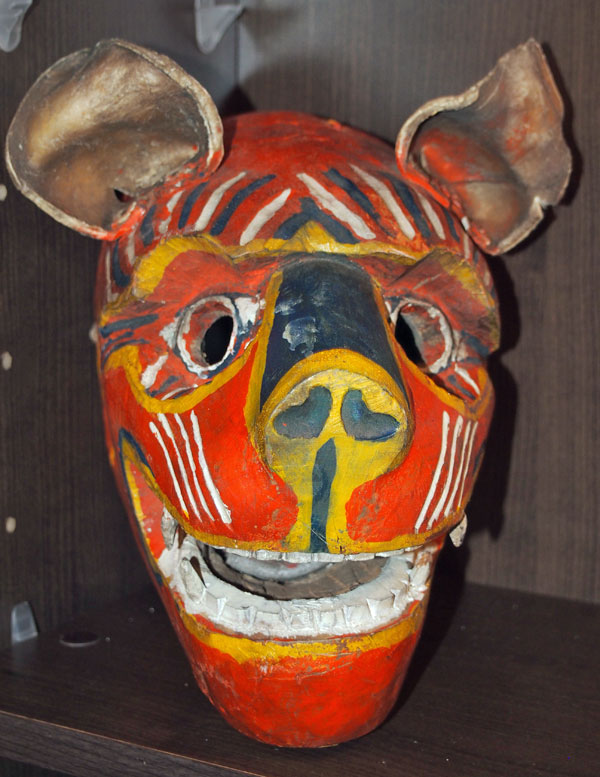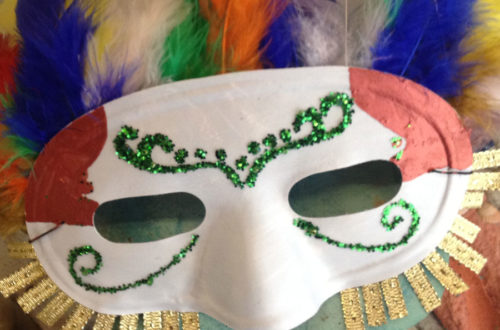 Q: I got this at an antique shop a few days back. At first I thought he was just an old souvenir tchotchke because there aren’t any holes in the side to keep this mask on someone’s head, instead there are four punctures in the back that look like they are for mounting. There is a dark, smooth looking stain in the wood just above the nostrils in back. The stain appears right where a person’s breath would hit if they actually wore this mask. Maybe someone wore it for something? Conceivably those four parallel punctures could have been for a head strap…
Q: I got this at an antique shop a few days back. At first I thought he was just an old souvenir tchotchke because there aren’t any holes in the side to keep this mask on someone’s head, instead there are four punctures in the back that look like they are for mounting. There is a dark, smooth looking stain in the wood just above the nostrils in back. The stain appears right where a person’s breath would hit if they actually wore this mask. Maybe someone wore it for something? Conceivably those four parallel punctures could have been for a head strap…
Also, the mask was repaired at one time. There’s a strengthening bit of wood attached with two small nails in back of the right cheek. It looks like it’s stabilizing a crack. There is also a small corresponding crack in the paint above the repair which makes me think the repair happened after the mask was painted (if they repaired it the same time they carved it, the paint would hide a crack this small) Also, a repair suggests USE to me for some reason, rather than decoration. The crack on the front is too small to really affect the mask’s aesthetics. But a weakness in the mask could affect it’s usefulness as a mask and make it more likely to break when being used.
Also the black lines on this mask were touched up at one point. I can see the outline of a second slightly smaller eyebrow underneath the black paint. Whoever did that touchup did it poorly and left a finger print. But there are certainly two kinds of black paint on this mask in varying gloss. Katherine, 1586
A: I have seen a few masks that look a little like this from Bali and Java, but not enough similarity to give me confidence. It would be nice if some viewers would make a helpful comment.






3 Comments
Katherine
Thank you so much for posting my mask! With your suggestion that it originates from Bali or Java, I might have just googled my way to some kind of an answer. It looks almost identical to a picture I found of what’s called the Jero Luh. It appears to be a female puppet/masquerade character. So it’s not a mask for a person at all, it’s a giant statue that gets a mask put on top of it, which would explain the size of this mask (quite big!). It would also explain why this mask doesn’t have a head strap, since it’s more or less part of a sculpture.
Here’s a stock photo. My mask looks really similar! It’s got the same lump on the head and everything. What do you think?
http://www.thinkstockphotos.com/image/stock-photo-barong-landung-bali-jero-luh-portrait/477190336
meslay
It is a mask of Bali’s Barung Landung
Eric Meslay Jero Luh is Jero Gede’s Giant’s wife and is working alongside him on the same occasions. This character is of Buddhist origin and, more precisely, derived from Chinese legends. Older than her husband, she breathes wisdom and knowledge and knows how to channel the passion of her husband by always guiding him on the right voice.
http://ombre.chinoise.free.fr/site_eric/masquebali2.htm
Barongs only exist in Bali. Their masks are extremely powerful. There are several types.
The Barong Landung are huge human characters representing a king and his wife.
They measure almost three meters in height. And of course, like humans, they only have two legs.
All the other Barongs have four. They are funny animals, tigers, elephants, cows, or lions that are the most impressive. They look a little like the Chinese lion dance.
It takes two dancers to animate them. One takes place in his head and snaps his jaws and the other moves his body and his long tail. As for most sacred masks, to make the head of the Barong, we use the wood of a beautiful pule tree that grows in the courtyard of a temple. Before cutting, a priest makes offerings and surrounds his trunk with a white cloth.
Then the sculptor takes the wood home and keeps it for several months in his family temple, before bringing it back to the temple to carve, sand and paint it on the spot.
All Barong coming from the same trunk are considered brothers and when the temple where this push tree celebrates its birthday, they must all come together to celebrate the event together.
Of course, the head is the most sacred part of Barong, and it is therefore to her that we owe the greatest respect.
Outside the season when the Barong occurs during ceremonies, she is unhooked from the rest of the body and preciously kept in the temple, on an altar, while her beautiful undulating tail is simply hanging on the wall, in another room.
The story told by the Barong dance is that of his struggle against the wicked witch, the widow Rangda.
This atrocious woman with evil powers, furious that no man accepts his daughter Ratna, sowed terror in East Java in the eleventh century. In order to stop him, a holy man, Empu Pradah, sent his son to marry the princess. He took the opportunity to steal the secrets of Rangda and thus, Empu finally managed to kill her. But the witch could be reincarnated!
Bob Ibold
Katherine seems to have solved the mystery…
“After you mentioned that the mask might be from Bali or Java, I did a little more digging with those locations in mind and with the help of your insight I might have googled my way to an answer. I think this is a Jero Luh mask, one of two beings in the Barong Landung dance and puppetry tradition. This mask depicts an old jolly woman from China, which explains why it’s design is hard to place. It’s made in Bali like you suspected, but it depicts a Chinese woman! There are unexpected visual and cultural cues going here for sure.
“Barong Landung masks apparently are not worn at all. Instead they are affixed to 9 foot tall giant puppets and danced around a bit like shadow puppets or marionettes. This explains a lot of my lingering questions about this mask. It seemed contradictory to me: The mask has real signs of use, what with the paint touch ups and the repair on the interior, and the fact that the top display hook was clearly a later addition. But how could this mask be used if it couldn’t be worn? The answer is, it never was. Those four parallel drill holes probably affixed to the ears and headdress portion of the mask, which in turn affixed it to the puppet. I guess the breath mark on the interior was a red herring.”